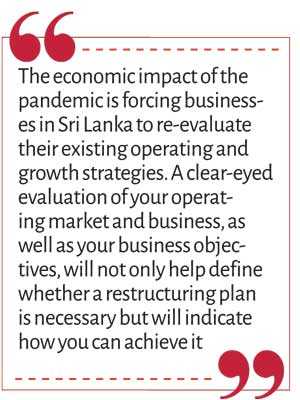Saturday Mar 15, 2025
Saturday Mar 15, 2025
Tuesday, 21 July 2020 00:10 - - {{hitsCtrl.values.hits}}

In the financial year 2000/01, a weak business environment resulted in Tata Motors reporting a loss for the first time
in 57 years. In response, it devised a comprehensive restructuring solution and Tata’s proactive restructuring efforts resulted in operating margins nearly tripling from 4% to 12%. Consequently, by the financial year 2002/03, the company became profitable once more
By Asia Securities
Investment Banking
In response to the pandemic, you, like many corporates have made tough decisions, including retrenching staff, instituting pay cuts, and deferring capital expenditure. But now, there are other questions you need to answer. How can I manage my business expenses in an uncertain recovery? How can I obtain fresh capital to support my business during this period? Where does the financial health of my suppliers stand? And customers?
Resilient businesses are the engine of Sri Lanka’s economy and will lead the way in driving the nation’s economic recovery. Business leaders need to take a holistic and strategic approach to restructure their businesses to kick-start growth and thrive in the ‘new normal’. In this article, the Asia Securities Investment Banking team explores how corporates can prepare and execute a focused financial restructuring strategy.
Where do I begin?
Start off with a thorough assessment of your company’s financial risk profile. For initial insight into the financial health of your company, ask yourself the following questions:
Is my business:
1.facing significant working capital constraints?
2.facing difficulties meeting operational expenses such as rent and salaries?
3.increasingly funding operations through overdrafts?
4.unlikely to meet debt repayment obligations post moratorium?
5.facing difficulties in attracting new capital?
If the answer to any of these questions is yes, your business is likely facing high financial and operational risk. You can address this threat by implementing an effective restructuring solution that will right-size your balance sheet and turn your business around.
The Tata turnaround: How the Indian multinational tripled profits with its targeted restructuring program
For example, in the financial year 2000/01, a weak business environment resulted in Tata Motors reporting a loss for the first time in 57 years. In response, it devised a comprehensive restructuring solution that:
Tata’s proactive restructuring efforts resulted in operating margins nearly tripling from 4% to 12%. Consequently, by the financial year 2002/03, the company became profitable once more.
To adopt and execute a restructuring strategy that is best suited for your business, CEOs must carefully consider several factors.
1.Understand the dynamic market landscape
A comprehensive market analysis should focus on 1) identifying value chain inefficiencies; 2) recognising likely risks; 3) evaluating the competitive landscape, and 4) highlighting new opportunities. A market analysis conducted by an independent, objective advisor can generate fresh insights and identify new opportunities.
2.Evaluate corporate objectives
Successful implementation of a restructuring strategy depends on thoroughly understanding your corporate objectives, developing a plan that balances the priorities of your different stakeholders, and executing the turnaround plan. Evaluating and defining clear objectives before a restructuring project will help you identify which restructuring strategies you should implement. An experienced advisor will be able to advise on the viability of each strategy and manage the process effectively to ensure you achieve your long-term objectives.
3.Understand investors’ perspective
Part of the restructuring may require bringing in external investors. In this case, reaching the right investors is critical to a successful outcome. This depends both on your requirement as well as the strategy and expectations of the investor. Therefore, it is essential to have a comprehensive understanding of investor expectations to ensure a successful capital raise.
What measures should I consider for a successful business recovery?
Once you have a strong understanding of your business outlook, corporate objectives, and investors’ perspective, you are better placed to execute the optimal recovery solution your business needs.
Review and redevelop your business strategy
A common shortcoming among businesses facing cashflow constraints in a crisis, is the absence of a responsive business plan. Hence, re-developing your business plan to ensure that it able to adapt to a changing environment is essential to overcome uncertainty and achieve long-term growth targets with minimal disruptions.
Financial restructuring to stabilise the firm’s financial position
Firms grappling with the financial implications of these volatile times can pursue multiple strategies to restructure their financial position and cash flows.
1.Re-negotiate credit terms with banks and other creditors - Understanding your creditors’ current position and providing them with a solid basis to make decisions is the first step towards a successful negotiation. To improve your credibility among creditors, evaluate your business’ outlook and develop a clear set of projections that demonstrate how the renegotiation of credit terms will enhance your business’ creditworthiness.
2.Review business operations to increase efficiency – Take a detailed look at your operational processes and identify specific initiatives such as re-organisation of production, employees and other redundant overheads that can increase productivity and efficiency.
3.Sale of unproductive and non-core assets – Consider disposing unproductive or non-core assets. Proceeds from the sale can be used to repay debt or provide liquidity to the business. This will also help focus management attention on the core business.
4.Raise external capital to bridge funding requirements – In a challenging economic environment, limiting deterioration of a company’s financial position may require raising equity capital. It may even be required by lenders as a condition of a debt restructuring. Raising additional capital may also create opportunities for a company to invest aggressively and grow market share when competitors are holding back.
A tailor-made plan with strong execution capabilities will drive a successful recovery
The economic impact of the pandemic is forcing businesses in Sri Lanka to re-evaluate their existing operating and growth strategies. A clear-eyed evaluation of your operating market and business, as well as your business objectives, will not only help define whether a restructuring plan is necessary but will indicate how you can achieve it.
Companies that engage with the right legal and financial advisors—with a track record of strong project execution—can gain valuable insights, expedite the process, and enhance the likelihood of maximising business value.
(Asia Securities is a leading investment firm in Sri Lanka providing Investment Banking, Research, Equities, and Wealth Management services to local and international corporate, institutional, and individual clients. Led by an internationally experienced team, with several decades of experience in global markets, Asia Securities Investment Banking team provides mergers and acquisitions, cross border transactions, corporate restructuring, capital raising, and strategic advisory services to both local and international clients. To become a client of Asia Securities, reach out via [email protected].)
Discover Kapruka, the leading online shopping platform in Sri Lanka, where you can conveniently send Gifts and Flowers to your loved ones for any event including Valentine ’s Day. Explore a wide range of popular Shopping Categories on Kapruka, including Toys, Groceries, Electronics, Birthday Cakes, Fruits, Chocolates, Flower Bouquets, Clothing, Watches, Lingerie, Gift Sets and Jewellery. Also if you’re interested in selling with Kapruka, Partner Central by Kapruka is the best solution to start with. Moreover, through Kapruka Global Shop, you can also enjoy the convenience of purchasing products from renowned platforms like Amazon and eBay and have them delivered to Sri Lanka.
Discover Kapruka, the leading online shopping platform in Sri Lanka, where you can conveniently send Gifts and Flowers to your loved ones for any event including Valentine ’s Day. Explore a wide range of popular Shopping Categories on Kapruka, including Toys, Groceries, Electronics, Birthday Cakes, Fruits, Chocolates, Flower Bouquets, Clothing, Watches, Lingerie, Gift Sets and Jewellery. Also if you’re interested in selling with Kapruka, Partner Central by Kapruka is the best solution to start with. Moreover, through Kapruka Global Shop, you can also enjoy the convenience of purchasing products from renowned platforms like Amazon and eBay and have them delivered to Sri Lanka.